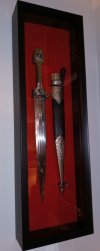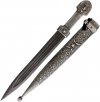- Joined
- Aug 4, 2013
- Messages
- 3,989
I'm curious to know if there are folks here that have any Kindjal Daggers within their collection of knives?
Btw, just like the Kukri has many ways of being spelled in the West, so too does the Kindjal. I personally choose to spell it "Kindjal" to keep things simple.
I don't currently own any vintage or antique specimens of a Kindjal, but do own two current day Russian made 'Kizlyar' company Kindjal Daggers...


I have another current production specimen that is made in the country of Georgia by 'VT Daggers' headed my way. This will be my first product purchase from this two man shop, so it's sort of a "dipping my toes in the water" thing in trying out some new sources of blades made elsewhere in the world, (it will be my first "made in Georgia" knife).
Here is the 'VT Daggers' brand mark...

And here is a stock photo of the model I have coming my way...

They make and sell them as traditionally handmade/handicraft daggers, not as standard factory production or as true custom made items, so, I'm sure that shows in their end result of their products, (which typically run in the $250 to $600 price range).
Here's the basic situation of 'VT Daggers'...
"VT Daggers is a father/son business operated by David Tolordava out of Tbilisi, Georgia, (the father is Vakhtang, and the son is David).
David's father, Vakhtang, creates each object entirely by hand using the same methods as his ancestors."
So, it's obvious that the "VT" letters in their brand name, stands for Vakhtang Tolordava, (the gentleman that actually makes them).
I was very curious about what seems in their pictures to be a lot of metal used for the hilt and scabbard of the 'VT Daggers' Kindjal I was ordering, but then found the following description/review of the process they use in making them, which I find to be rather cool

 ...
...
"The hilt is made via electrotyping, which Georgians adopted the use of in the nineteenth century.
The process involves making a mold, coating the inner surface of the mold with metallic paint (graphite is widely used), submerging the mold in a solution containing copper, and running a current through the solution to draw off the copper until it grafts itself onto the surface of the mold. It's a fascinating process and I recommend you search youtube for a few videos. The raw hilt is hollow, but the walls are thick enough to be stable. The copper hilt is smoothed and dipped in silver until it comes out nice and shiny. In some of the photos below you can see the silver has a slightly orange tint from the copper underneath. The embossed recesses of the hilt are filled with niello, a metallic black substance consisting of copper, silver, sulphur and lead to create a beautiful contrast.
The tang of the blade was traditionally secured to the hilt with pitch (resin), which was the same historic method used to build the Indian tulwar, but Vakhtang uses protacryl, the same substance used to make modern dental fillings! The entire sword feels very secure, no rattling whatsoever. There is no gap whatsoever between the hilt and the blade; it is TIGHT."
As for the decorative use of 'Niello' on it, here is a description of it I found online...
"Niello is a black mixture, usually of sulphur, copper, silver, and lead, used as an inlay on engraved or etched metal, especially silver. It is added as a powder or paste, then fired until it melts or at least softens, and flows or is pushed into the engraved lines in the metal."
Anyhow, I've started this thread in hopes to see what Kindjal Daggers you folks may have within your own collections, (new, vintage, or antique).
Please share pictures of any you may own, and share any pertinent information about them, or pertinent information in general about Kindjal Daggers


Btw, just like the Kukri has many ways of being spelled in the West, so too does the Kindjal. I personally choose to spell it "Kindjal" to keep things simple.
I don't currently own any vintage or antique specimens of a Kindjal, but do own two current day Russian made 'Kizlyar' company Kindjal Daggers...


I have another current production specimen that is made in the country of Georgia by 'VT Daggers' headed my way. This will be my first product purchase from this two man shop, so it's sort of a "dipping my toes in the water" thing in trying out some new sources of blades made elsewhere in the world, (it will be my first "made in Georgia" knife).
Here is the 'VT Daggers' brand mark...

And here is a stock photo of the model I have coming my way...

They make and sell them as traditionally handmade/handicraft daggers, not as standard factory production or as true custom made items, so, I'm sure that shows in their end result of their products, (which typically run in the $250 to $600 price range).
Here's the basic situation of 'VT Daggers'...
"VT Daggers is a father/son business operated by David Tolordava out of Tbilisi, Georgia, (the father is Vakhtang, and the son is David).
David's father, Vakhtang, creates each object entirely by hand using the same methods as his ancestors."
So, it's obvious that the "VT" letters in their brand name, stands for Vakhtang Tolordava, (the gentleman that actually makes them).
I was very curious about what seems in their pictures to be a lot of metal used for the hilt and scabbard of the 'VT Daggers' Kindjal I was ordering, but then found the following description/review of the process they use in making them, which I find to be rather cool
"The hilt is made via electrotyping, which Georgians adopted the use of in the nineteenth century.
The process involves making a mold, coating the inner surface of the mold with metallic paint (graphite is widely used), submerging the mold in a solution containing copper, and running a current through the solution to draw off the copper until it grafts itself onto the surface of the mold. It's a fascinating process and I recommend you search youtube for a few videos. The raw hilt is hollow, but the walls are thick enough to be stable. The copper hilt is smoothed and dipped in silver until it comes out nice and shiny. In some of the photos below you can see the silver has a slightly orange tint from the copper underneath. The embossed recesses of the hilt are filled with niello, a metallic black substance consisting of copper, silver, sulphur and lead to create a beautiful contrast.
The tang of the blade was traditionally secured to the hilt with pitch (resin), which was the same historic method used to build the Indian tulwar, but Vakhtang uses protacryl, the same substance used to make modern dental fillings! The entire sword feels very secure, no rattling whatsoever. There is no gap whatsoever between the hilt and the blade; it is TIGHT."
As for the decorative use of 'Niello' on it, here is a description of it I found online...
"Niello is a black mixture, usually of sulphur, copper, silver, and lead, used as an inlay on engraved or etched metal, especially silver. It is added as a powder or paste, then fired until it melts or at least softens, and flows or is pushed into the engraved lines in the metal."
Anyhow, I've started this thread in hopes to see what Kindjal Daggers you folks may have within your own collections, (new, vintage, or antique).
Please share pictures of any you may own, and share any pertinent information about them, or pertinent information in general about Kindjal Daggers
Last edited:



